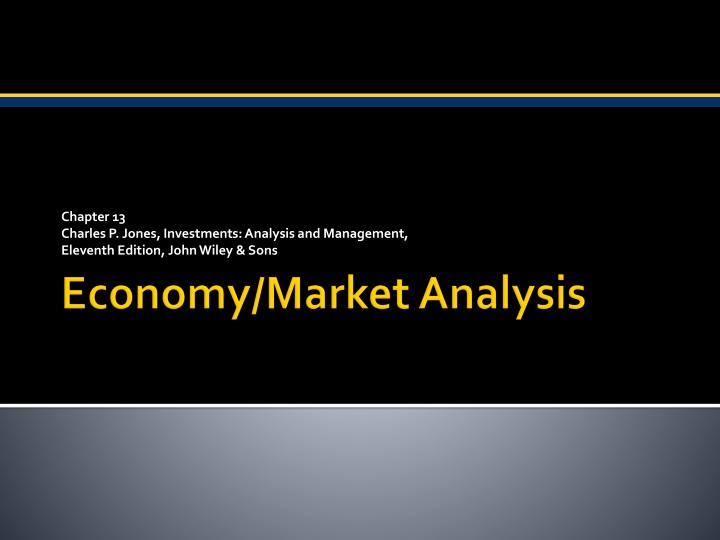
Stock Market Analysis and Economic Indicators
Delve into the world of investments with a focus on analyzing the stock market, industries, and individual companies. Explore economic factors affecting stock prices, valuation models, and forecasting techniques. Gain insights into the interplay between market indicators, economic cycles, and central bank research. Discover the crucial relationship between stock prices and the economy, as well as the significance of market yields and time to maturity.
Download Presentation

Please find below an Image/Link to download the presentation.
The content on the website is provided AS IS for your information and personal use only. It may not be sold, licensed, or shared on other websites without obtaining consent from the author. If you encounter any issues during the download, it is possible that the publisher has removed the file from their server.
You are allowed to download the files provided on this website for personal or commercial use, subject to the condition that they are used lawfully. All files are the property of their respective owners.
The content on the website is provided AS IS for your information and personal use only. It may not be sold, licensed, or shared on other websites without obtaining consent from the author.
E N D
Presentation Transcript
Chapter 13 Charles P. Jones, Investments: Analysis and Management, Eleventh Edition, John Wiley & Sons
Analyze economy-stock market industries individual companies Need to understand economic factors that affect stock prices initially Use valuation models applied to the overall market and consider how to forecast market changes Stock market s likely direction is of extreme importance to investors Should also take a global perspective because of linkages
Direct relationship between the two Economic business cycle Recurring pattern of aggregate economic expansion and contraction Cycles have a common framework bottom peak bottom Lengths and turning points can only be neatly categorized in hindsight
Central Bank -Economic Research Monitors economic indicators Dates business cycle when possible Composite indexes of general economic activity Series of leading, coincident and lagging indicators of economic activity to assess the status of the business cycle
Stock prices lead the economy Historically, the most sensitive indicator Stock prices consistently turn before the economy How reliable is the relationship? The ability of the market to predict recoveries is much better than its ability to predict recessions
Shows relationship between market yields and time to maturity, holding all other characteristics, like credit risk, constant Upward sloping and steepening curve implies accelerating economic activity Flat structure implies a slowing economy Inverted curve may imply a recession Actions of Central Bank, expectations important
Market measured by index or average Most indexes designed for particular market segment (ex. blue chips) Most popular indexes All Share Price Index S&P 20 SL
Shows how stocks in general are doing at any time Gives a feel for the market Shows where in the cycle the market is and sheds light on the future Aids investors in evaluating downside Helps judge overall performance Used to calculate betas
Corporate earnings and expected inflation affects expected earnings Interest rates and required rates of return also affected by expected inflation Stock prices affected by earnings, rates If economy is prospering, earnings and stock prices will be expected to rise
From constant growth version of Dividend Discount Model P0=D1/(k-g) Inverse relationship between interest rates (required rates of return) and stock prices are not linear Determinants of interest rates also affect investor expectations about future
To apply fundamental analysis to the market, estimates are needed of Stream of shareholder benefits Earnings or dividends Required return or earnings multiple Steps in estimating earnings stream Estimate GDP, corporate sales, corporate earnings before taxes, and finally corporate earnings after taxes
The earnings multiplier More volatile than earnings component Difficult to predict Cannot simply extrapolate from past P/E ratios, because changes can and do occur P/E ratios tend to be high when inflation and interest rates are low Why? Put earnings estimate and multiplier together
Difficult to consistentlyforecast the stock market, especially short term EMH states that future cannot be predicted based on past information Although market timing difficult, some situations suggest strong action Investors tend to lose more by missing a bull market than by escaping a bear market
Leading relationship exists between stock market prices and economy Can the market be predicted by the stage of the business cycle? Consider business cycle turning points well in advance, before they occur Stock total returns could be negative (positive) when business cycle peaks (bottoms)
If investors can recognize the bottoming of the economy before it occurs, a market rise can be predicted Switch into stocks, out of cash As economy recovers, stock prices may level off or even decline Based on past, the market P/E usually rises just before the end of the slump
Best known market indicator is the price/earnings ratio Other indicators: price to book value, dividend yield Problems with key market indicators: When are they signaling a change? How reliable is the signal? How quickly will the predicted change occur?
Market forecasts are not easy, and are subject to error Investors should count on the unexpected occurring Intelligent and useful forecasts of the market can be made at certain times, at least as to the likely direction of the market
